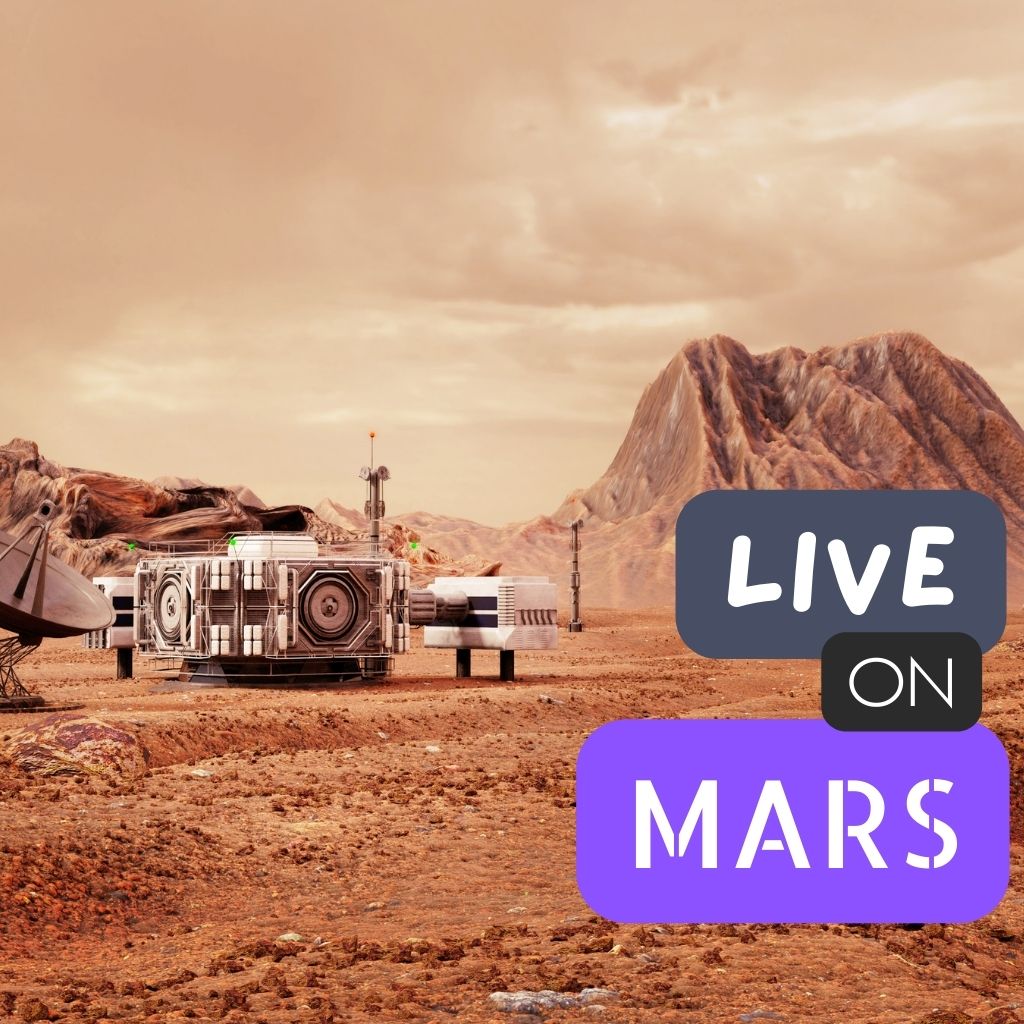This site contains affiliate links to products. I may receive a commission for purchases made through these links.
Mars has fascinated humans for centuries, and with recent advancements in technology, the idea of living on Mars has become more realistic than ever before.
There are many reasons why Mars could be a potential destination for human habitation, and in this article, we will explore some of the most compelling reasons.
So, if you’ve ever wondered what it would be like to live on another planet, keep reading to find out why Mars might just be our best bet.
Can humans live on Mars?
Humans can potentially live on Mars, but some many challenges and obstacles need to be overcome before it can become a reality. The Red Planet has a thin atmosphere and lacks a magnetic field, which means it is exposed to high levels of radiation and solar winds.
The planet’s extreme temperatures and lack of water make it difficult for humans to survive without advanced technology and infrastructure.
Despite these challenges, there are ongoing efforts to establish a human presence on Mars, including plans for manned missions and technology development to support human life on the planet.
Can Mars support human life?
Mars is a harsh environment with extremely low atmospheric pressure, no breathable air, and extreme temperatures. However, humans can survive and even thrive on Mars with the right technology and infrastructure.
One of the primary requirements for human survival on Mars is generating and maintaining a sustainable supply of resources such as air, water, food, and energy.
Some of the proposed methods for achieving this include using greenhouse technology to grow crops, extracting water from the Martian soil and atmosphere, and generating energy from solar panels or nuclear power.
Another significant challenge for human habitation on Mars is the exposure to high levels of radiation, as the planet lacks a protective magnetic field. To mitigate this risk, habitats can be constructed with radiation-shielding materials or be located in underground tunnels or caves.
Despite the numerous challenges, significant progress has been made in recent years towards making human colonization of Mars a reality. Several space agencies and private companies are actively working on developing the necessary technologies and infrastructure for this ambitious goal.
What are the features of the Red Planet Mars?
Let’s explore the various features of Mars, including its physical characteristics, atmosphere, climate, and other notable traits.
Mars has a thin atmosphere
Mars has a thin atmosphere that is mostly composed of carbon dioxide (CO2). Its atmosphere is about 1% as dense as Earth’s atmosphere.
The thin atmosphere of Mars makes it a hostile place for humans to live without protective gear, as it lacks sufficient oxygen and air pressure.
Mars has a cratered surface

Mars has a rocky, cratered surface with valleys, canyons, and mountains. The planet’s surface is covered in iron oxide, giving it a reddish-brown color. The average temperature on Mars is approximately -81 degrees Fahrenheit.
Temperature fluctuations occur between extreme lows of about -220 degrees Fahrenheit during winter at the poles to highs of up to +70 degrees Fahrenheit during summer in the lower latitudes.
Mars has polar ice caps
Mars has two polar ice caps made of water and carbon dioxide. The northern polar ice cap is made mostly of water ice, while the southern polar ice cap is made mostly of carbon dioxide ice.
The polar ice caps on Mars grow and shrink depending on the season and have been observed to have layers that may hold clues to Mars’ past climate.
Mars has the largest canyon in the solar system
Valles Marineris is a massive canyon system on Mars, measuring about 4,000 km long, 200 km wide, and up to 7 km deep. It is the largest known canyon system in the solar system and is thought to have been formed by tectonic activity.
The canyon contains numerous features, such as cliffs and landslides, making it a popular site for scientific study and exploration.
Mars has the largest volcano in the solar system
Mars is home to the largest volcano in the solar system, Olympus Mons. This shield volcano is about 16 miles (25 kilometers) high and has a diameter of 370 miles (600 kilometers).
This shield volcano is one of the youngest volcanic features on the planet, estimated to be only 100 million years old. Its unique structure and size are due to Mars’ lack of plate tectonics and the relatively low viscosity of the lava that formed it.
Despite its massive size, Olympus Mons has a gentle slope and a relatively flat summit, making it a popular target for future Mars missions.
Mars also has other smaller volcanoes, including the extinct Tharsis volcanoes. The presence of these volcanoes suggests that Mars has a relatively active geology and a history of volcanic activity.
Mars has intense dust storms
Mars is known for its intense dust storms that can cover the entire planet for weeks or even months at a time. These dust storms are caused by strong winds that kick up dust particles from the Martian surface.
The thin atmosphere of Mars makes it easier for the dust to stay suspended in the air for extended periods. These storms can pose a significant challenge for future manned space exploration, as they can interfere with solar power generation, disrupt communications, and damage equipment.
Mars has four seasons
Mars has seasons, much like Earth, although they are longer due to the planet’s longer orbit around the Sun. Mars’ axial tilt is similar to Earth’s, which means it experiences similar seasonal changes, including temperature and weather patterns.
The Martian seasons are also affected by the planet’s elliptical orbit, which causes significant variations in the length of the seasons. The seasons on Mars could play a significant role in future manned missions, as they may affect the availability of resources such as water and the potential for crop growth.
Mars has two moons

Mars has two small moons, Phobos and Deimos. These moons are irregularly shaped and are thought to be captured asteroids.
They are relatively small, with Phobos being the larger of the two moons at about 14 miles (22 kilometers), while Deimos is only about 8 miles (13 kilometers).
To catch a glimpse of Mars and its two moons, consider getting a telescope like the Celestron NexStar 6SE. It is a computerized telescope with a 6-inch aperture and a focal length of 1500mm.
Its high-quality optics allow users to view Mars in clear detail, including its polar ice caps, dust storms, and surface features.
Another great option is the Meade Instruments LX90 Telescope. It is a high-end telescope with an 8-inch aperture and a focal length of 2000mm.
It features a computerized mount that can be controlled through an app, allowing users to find and track Mars easily.
And if you are looking for a cheaper option, Orion SkyQuest XT8 Telescope is your sure bet. It is a classic Dobsonian telescope with an 8-inch aperture and a focal length of 1200mm.
The large aperture will help you see Mars clearly, including its surface features and polar ice caps.
You may also like: What Telescope Size Do I Need to See Mars?
8 reasons why humans can live on Mars
There are several reasons why humans can potentially live on Mars, including the planet’s proximity to Earth, the availability of water and resources, the possibility of terraforming, the potential for scientific discoveries and advancements, and the drive for human exploration and expansion beyond Earth.
Let’s discuss them in detail
1. Proximity to Earth
The planet Mars is one of the most promising options for human colonization within our solar system, largely due to its proximity to Earth.
At its closest approach, Mars is approximately 34 million miles away from Earth, making it a much more accessible destination compared to other planets, such as the gas giants Jupiter or Saturn. This means that it would be easier to establish communication and transport supplies and equipment between Earth and Mars.
2. Availability of water and other resources on Mars
One of the primary requirements for life is water, and Mars has it in the form of ice and water vapor. The presence of water on Mars is one of the most significant findings in recent years.
Although the water is not easily accessible, scientists have identified numerous locations where water may be found. NASA’s Mars Reconnaissance Orbiter has captured images of gullies, channels, and valleys suggesting water was once on the planet’s surface.
The discovery of water on Mars means that we may be able to sustain life on the planet in the future. This water can potentially be extracted and used for drinking, agriculture, and other purposes.
Also, Mars has abundant reserves of minerals and elements that can be mined and utilized for various purposes.
3. The possibility of terraforming Mars
The possibility of terraforming presents an intriguing option for transforming Mars into a more habitable planet for humans. Terraforming involves altering a planet’s atmosphere and surface conditions to make it more suitable for life.
In the case of Mars, this could involve releasing greenhouse gases into the atmosphere to warm up the planet and melt the water ice, creating a thicker atmosphere that can protect against solar radiation and establishing a stable ecosystem that can sustain life.
4. Similar day and night cycle to Earth
Mars has a day and night cycle similar to Earth’s, which makes it easier for humans to adapt to the new environment. A Martian day, or sol, is slightly longer than Earth at 24 hours and 39 minutes.
The planet’s tilt is also similar to Earth’s, which means that it experiences seasons, albeit more extreme than on Earth. This cycle provides an opportunity to develop farming techniques to grow crops on Mars.
5. Access to sunlight
Mars receives enough sunlight to sustain human life. Although Mars is further from the Sun than Earth, its thin atmosphere allows more sunlight to penetrate the surface.
Solar panels can be used to harness the energy of the sun to power equipment and create habitats on the planet.
6. Space exploration and research
Robotic Mars missions have been successful, and human missions to Mars will provide the opportunity to conduct more detailed research.
Mars exploration has already provided valuable information about the planet’s geology, climate, and habitability.
Human exploration and research will provide an even greater understanding of the planet and the potential for life.
7. Advancements in technology
Advancements in technology will make it possible for humans to live and work on Mars. The development of new materials, such as high-strength composites and lightweight alloys, has made it possible to create habitats and equipment that can withstand the harsh environment on Mars.
3D printing technology has also been developed to create structures and tools on-site.
8. Planetary protection
Humans on Mars can be protected from the harsh environment through the development of advanced spacesuits and habitats. Spacesuits can protect humans from extreme temperatures, lack of oxygen, and high radiation levels on Mars.
Habitation modules can be designed to provide a controlled environment with air, water, and food. These systems can also be designed to recycle waste and provide a sustainable life-support system.
What are the conditions needed for life to thrive on Mars?
While there are numerous possibilities for human habitation on Mars, there are specific key conditions that must be met to support thriving life on the planet.
Mars is a harsh and inhospitable environment for life as we know it. If we are to establish a human presence on Mars, we need to understand the conditions needed for life to thrive there.
Here are some of the conditions necessary for life on Mars:
Suitable temperature
Temperatures on Mars are an important factor in supporting life on the planet. To support human habitation, the planet’s surface must be warmed up to maintain a more stable and livable environment.
This could potentially be achieved through the release of greenhouse gases into the atmosphere or by harnessing solar energy to generate heat.
The average temperature on Mars is significantly colder than Earth, with temperatures ranging from -80 degrees Fahrenheit to 68 degrees Fahrenheit.
Provision of water
If humans are to survive on Mars, they would need a steady supply of water for drinking, growing food, and other activities. Water is essential for life as we know it, and evidence suggests that Mars may have had liquid water in the past.
Today, water on Mars exists mostly in the form of ice, which can be found in the polar ice caps and just below the surface in some areas.
Stable and breathable atmosphere
Another critical condition for life to thrive on Mars is a stable and breathable atmosphere. To support human habitation, the atmosphere must be modified to include sufficient oxygen levels and other gases necessary for human survival.
This process is known as terraforming and involves significant scientific and engineering challenges that require the development of new technologies and the generation of sustainable living systems.
Currently, the Martian atmosphere is very thin and composed primarily of carbon dioxide, making it unsuitable for humans to breathe.
Protection from harmful radiation
To mitigate the risks associated with radiation exposure, human habitats and living quarters on Mars must be shielded and designed to withstand these extreme conditions.
This could involve the use of materials that can block or absorb radiation, the construction of underground habitats, or the development of new technologies to protect against radiation exposure.
One of the most significant challenges for human habitation on Mars is the planet’s exposure to harmful radiation.
Mars lacks a magnetic field that can protect against solar radiation, leaving the planet’s surface exposed to intense radiation levels that can be harmful to human health.
Presence of normal gravity
For humans to survive on Mars, we need normal gravity. Mars has only 38% of Earth’s gravity, which could have significant implications for human health.
Studies have shown that long-term exposure to reduced gravity can lead to muscle and bone loss and other health problems. To mitigate these effects, humans need to exercise regularly and take other measures to maintain their health.
What are the pros of living on Mars?
Living on Mars presents an exciting opportunity to experience life on another planet. There are several advantages to living on Mars, which are outlined below:
Planetary science advancements
One of the primary benefits of establishing a colony on Mars is the opportunity to gain a better understanding of the planet.
With a permanent presence on the planet, scientists can carry out research and experiments that would not be possible through rovers or occasional missions. Such research could lead to valuable discoveries, new technologies, and advancements in planetary science.
Resource utilization
Mars is a treasure trove of resources that can sustain human life and support future missions. For example, Mars has water in the form of ice, which can be melted and used for drinking, irrigation, and fuel.
The planet also has a significant amount of carbon dioxide in its atmosphere, which can be converted into oxygen and used for breathing.
Planetary backup
As a species, we are vulnerable to global catastrophes such as pandemics, climate change, and asteroid impacts. Establishing a human settlement on Mars would serve as a backup plan. This will ensure that humanity can survive even if Earth becomes uninhabitable.
Innovation and technological advancements
The challenges of living on Mars would require developing new technologies and solutions to overcome them. This would spur innovation and lead to the development of new technologies that could also have applications on Earth.
For instance, developing a self-sustaining colony on Mars would require developing advanced life support systems, efficient recycling and waste management, and renewable energy sources.
New opportunities and experiences
Living on Mars would offer new opportunities and experiences that are not possible on Earth. From exploring new terrain, studying a novel ecosystem, and establishing a new society, colonizing Mars would offer a chance for humans to expand their horizons and challenge themselves in new ways.
What are the cons of living on Mars?
Living on Mars also has its challenges, and several disadvantages must be considered before establishing human habitation on the planet. Here are some of the challenges:
Harsh living conditions
Living on Mars would require humans to endure harsh living conditions, including extreme temperatures, high levels of radiation, and low atmospheric pressure.
Mars is much colder than any temperature recorded on Earth. Mars also has much less atmospheric pressure than Earth, meaning humans would need to live in enclosed environments to survive.
Limited resources
Unlike Earth, Mars does not have abundant natural resources that can sustain human life. This means that everything from food to building materials would need to be brought from Earth or manufactured on Mars using limited resources.
Additionally, water on Mars is primarily found in the form of ice, which would need to be extracted and purified for human consumption.
Lack of a thick atmosphere
Mars does not have a strong magnetic field or a thick atmosphere, which means it is not protected from the harsh solar winds that could damage human health and equipment.
The thin atmosphere also means that Mars experiences frequent dust storms that can last for months, hindering visibility and potentially damaging equipment.
Long travel time
Traveling to Mars would require a significant amount of time, with current estimates ranging from 6 to 8 months. This poses significant health risks to humans, including exposure to radiation and muscle atrophy due to prolonged weightlessness.
Psychological challenges
Living on Mars would also pose psychological challenges, as humans would be living in isolated and confined environments for extended periods. This could lead to a range of mental health issues, including depression, anxiety, and stress.
FAQs about the Red Planet
Here are some frequently asked questions about Mars:
What does the current climate on Mars reveal about the past?
Some research has been conducted to discover if life forms existed on Mars. There is evidence that Mars had a much thicker atmosphere in the past, which would have allowed liquid water to flow on the surface.
The presence of channels and valleys on Mars suggests that water once flowed on its surface, indicating that Mars may have had a warm and wet climate at some point in its history that may have supported past life.
Furthermore, recent discoveries by NASA’s Mars rover missions have revealed evidence of ancient lakes and river deltas, as well as minerals that can only form in the presence of liquid water. These findings suggest that Mars had a much more habitable environment in the past, which could have potentially supported life.
Why is it better to live on Mars than the moon?
Mars is a more viable option for human colonization compared to the moon for the following reasons:
- Martian day/night cycle is similar to that of Earth, making it easier for humans to adapt to the environment.
- The presence of water on Mars makes it a better candidate for supporting life.
- The planet’s atmosphere, while not breathable, is much denser than the moon’s, providing some protection against cosmic and solar radiation.
- Mars has a diverse landscape, including valleys, canyons, and mountains, which could be used for scientific exploration and resource extraction.
Why is living on Earth better than living on Mars?
Living on Earth offers many advantages over living on Mars. Earth has a breathable atmosphere, moderate temperatures, abundant water, and a protective magnetic field that shields us from the harmful effects of solar radiation. Earth is a rich and diverse planet with an abundance of life, resources, and opportunities for exploration and discovery.
While Mars may have some advantages, such as lower gravity and the potential for terraforming, it lacks many of the essential features that make Planet Earth such a hospitable and thriving planet.
Takeaway: Human exploration has revealed several reasons humans can potentially live on Mars
The idea of human colonization on Mars has been a subject of interest and research for many years. While there are several reasons to believe that humans can survive on Mars, including the presence of water, a relatively hospitable environment, and the possibility of terraforming the planet, there are also numerous challenges and risks associated with living on Mars.
The journey to Mars is a long and challenging one, and the risks and challenges of establishing a permanent human settlement on the planet cannot be understated. Future human explorers may face many challenges when it comes to colonizing Mars.
Nonetheless, the quest for space exploration and the desire to expand human civilization beyond Earth remains an exciting and compelling prospect that continues to capture the imagination of scientists and the general public.
You may also like:







